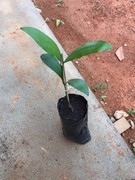1
Tropical Fruit Discussion / Re: NEW BOOK: Frutas No Brasil, Nativas e Exoticas (Fruits in Brazil)
« on: June 29, 2021, 10:39:59 PM »To people who have this book: how much info/pictures does it have on Theobromas and Herranias? I’m thinking of getting it, but it’s quite expensive, and I mainly am interested in lots of pictures and info on theobromas/herranias.
One-page entries for each of the following species:
- Herrania balaensis
- Herrania mariae
- Theobroma bicolor
- Theobroma cacao (somewhat surprising that they didn't illustrate cultivars)
- Theobroma grandiflorum
- Theobroma obovatum
- Theobroma speciosum
- Theobroma subincanum
- Theobroma sylvestre
Each page has three photos: a close-up of fruit (whole and opened); close-up of leaves/flowers; image of the tree on its own.



